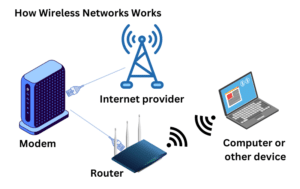In our increasingly interconnected world, wired and wireless networks have become the lifeblood of communication, sharing, and collaboration.
They’re the invisible highways that make possible everything from the morning emails we send to our colleagues, to the streaming movies we binge-watch on quiet evenings.
As technology continues to evolve, our understanding of networks must grow alongside it. But what exactly are these networks, and how do they work?
More importantly, what’s the difference between wired and wireless networks, and how do we decide which one to use?
This guide offers a thorough analysis of wired and wireless networks, highlighting their functions, pros, cons, and best uses. It also helps you choose the right network and previews their future. Don’t miss our article on the Top 5 Networking Technologies of 2024.
Are you optimizing your home or office network for peak performance? Discover how the right router and WiFi booster can transform your online experience. Let’s connect and explore the dynamic world of networking.
Definition of Networks
Before we delve into the world of wired and wireless networks, it’s important to first understand what a network is.
At its most fundamental level, a network is a system of interconnected computers, servers, and other devices that allow for data exchange.
These connections can facilitate a wide range of operations, from sharing files, applications, and databases, to enabling communication through email, video conferencing, and instant messaging.
Networks can be categorized based on a variety of factors, including:
- Geographical span:
- Local Area Networks (LANs)
- Metropolitan Area Networks (MANs)
- Wide Area Networks (WANs)
- Structure:
- Client-server
- Peer-to-peer
- Type of connections:
- Wired
- Wireless
In this guide, our focus will be on the latter category – wired and wireless networks.
Both have their unique characteristics, advantages, and disadvantages. They can also be best suited to different kinds of environments and use cases.
Understanding these differences will help you make an informed decision when setting up a network for your home or business, or simply broaden your knowledge of how our interconnected world operates.
In the following sections, we will take a closer look at both wired and wireless networks, exploring how they work, where they excel, and where they may fall short.
Let’s begin by exploring the realm of wired networks!
Understanding Wired Networks
When we talk about wired networks, we’re referring to networks where data is transmitted through physical pathways.
These pathways can take the form of various cabling systems such as coaxial cables, Ethernet cables, or even fiber-optic cables.
Types of wired networks
There are several types of wired networks, with the most common ones being Ethernet and Fiber Optic networks.
Ethernet Networks:
This is the most common type of network used for creating LANs. They employ Ethernet cables, which are usually made up of copper, to connect devices like computers, routers, and switches.
Ethernet networks are reliable and offer decent data transfer speeds, making them ideal for small to medium-sized businesses and homes.
Fiber Optic Networks:
Fiber optic networks, on the other hand, use light signals to transmit data over thin strands of glass or plastic known as fiber optic cables.
They are known for their high-speed data transfer capability, often being employed in WANs or in environments where high data throughput is required, such as data centers and large enterprises.
Coaxial Cable Networks:
Once the mainstay of cable television and early computer networks, coaxial cable networks are less common today but are still used in some contexts.
These networks use cables with a core conductor and outer shielding, providing good resistance to interference.
How Wired Networks Work
In a wired network, devices are physically connected via cables to a network switch or router.
The data is converted into electrical signals (or light signals in the case of fiber optic networks) which are then transmitted over the cable to the receiving device.
Each device on the network has a unique address, ensuring the data is sent to the correct destination.
Advantages
Wired networks offer several benefits:
- Speed: Wired networks often provide faster data transfer speeds compared to their wireless counterparts. Especially with modern Ethernet and fiber-optic cables, high-speed data transfer is achievable.
- Reliability: Because they use physical connections, wired networks are less likely to experience interference or signal loss, resulting in more stable and consistent connections.
- Security: Wired networks tend to be more secure as they’re harder to intercept compared to wireless networks. Physical access to the network is typically required for unauthorized access.
Disadvantages
However, wired networks also come with a few drawbacks:
- Limited Mobility: Since devices need to be physically connected to the network, moving around can be a challenge in wired networks. This can limit flexibility, especially in larger or more dynamic environments.
- Installation Complexity and Cost: Wired networks can be complex and costly to install, especially in large buildings. Running cables through walls and ceilings, and managing the physical infrastructure can require significant time and resources.
- Aesthetics: From a design perspective, visible network cables may not always be desirable in certain settings.
Enhancing Network Security with a VPN
In exploring wired and wireless networks, it’s vital to consider network security, especially as data breaches and cyber threats grow more frequent.
Wireless networks, in particular, face higher risks of unauthorized access.
A robust solution like NordVPN, which encrypts your internet traffic, is key to securing your data across any network.
Whether using private or public Wi-Fi, NordVPN is essential for safeguarding your online presence.
Enhance your digital security with NordVPN, available through our link here.
Suitable Scenarios for Using Wired Networks
Given their characteristics, wired networks are often best suited for environments where speed, reliability, and security are paramount. This includes office settings, gaming environments, or situations where large files are frequently transferred across the network.
Despite the rise of wireless networks, the dependability of wired networks means they continue to play a crucial role in our digital landscape.
In the next section, we’ll switch gears and dive into the world of wireless networks, discussing how they operate and where they can be most effectively utilized.
Understanding Wireless Networks
While wired networks rely on physical connections, wireless networks allow devices to connect and communicate without the need for cables. These networks leverage radio waves or infrared signals to transmit data, offering a degree of freedom and flexibility that wired networks can’t match.
Types of Wireless Networks
There are several types of wireless networks, with Wi-Fi, Bluetooth, and Cellular networks being some of the most recognized.
- Wi-Fi Networks: These are perhaps the most well-known type of wireless network. Wi-Fi uses radio waves to connect devices like laptops, smartphones, and smart home devices to the internet or each other, typically over short to medium distances.
- Bluetooth Networks: Bluetooth networks enable communication between devices over short distances. They’re typically used for connecting peripherals like wireless mice, keyboards, or headphones to a computer or smartphone.
- Cellular Networks: Cellular networks, used by mobile phones and some IoT devices, leverage a large network of fixed-location cell towers to provide wide-ranging wireless coverage. These networks support voice calls, SMS, and data services, such as 4G and 5G internet access.
How Wireless Networks Work
In a wireless network, data is transmitted as electromagnetic waves.
These signals are picked up by a wireless-enabled device, like a smartphone or laptop, using a wireless adapter.
Just like in a wired network, each device has a unique address to ensure data is received by the intended recipient.
Advantages
Wireless networks come with several distinct advantages:
- Mobility: The most apparent advantage is mobility. Without the need for physical cables, devices can move freely within the network’s range.
- Ease of Installation: Wireless networks can be easier and cheaper to install and expand than wired networks, particularly in challenging environments.
- Scalability: Adding new devices to a wireless network is usually as simple as connecting to the network, making it highly scalable.
Disadvantages
However, wireless networks also have their share of challenges:
- Interference: Wireless signals can be subject to interference from other electronic devices or physical obstacles, potentially causing a drop in connection quality or speed.
- Security: While wireless networks can be secured, they are inherently more open to potential security threats than wired networks. Extra precautions are necessary to keep them secure.
- Speed and Range Limitations: While advancements like 5G are mitigating this issue, wireless networks generally offer slower speeds than wired ones, especially over longer distances.
Suitable Scenarios for Using Wireless Networks
Wireless networks are ideally suited for environments where mobility and flexibility are key.
This includes homes, public spaces, and modern office environments that promote a dynamic, moving workforce.
Moreover, with the growing trend of IoT devices, wireless networks are becoming increasingly prevalent.
Optimizing Connectivity with the Right Router
In the realm of wired networks, the router is a pivotal element, acting as the central hub for network traffic. Its role extends beyond mere connectivity; it fundamentally shapes network performance. When choosing a router, consider these key features:
- Speed: Essential for high-bandwidth activities like streaming and gaming. Look for routers offering high data transfer rates.
- Range: Crucial for covering larger spaces without signal degradation.
- Number of Connections: Ensure the router can handle multiple devices simultaneously without compromising performance.
- Security Features: Advanced routers come with enhanced security protocols to safeguard your network against cyber threats.
For those seeking an ideal balance of these features, TP-Link AXE5400 or the Amazon eero 6+ stands out. These routers are designed to meet the diverse needs of both home and office networks, providing strong performance and enhanced security.
Table of comparison
| Feature | TP-Link AXE5400 | Amazon eero 6+ |
| Wi-Fi Technology | Tri-Band WiFi 6E, up to 5400 Mbps (5.4 Gbps) | Wi-Fi 6, up to 1000 Mbps (1 Gbps) |
| Speed & Bandwidth | 6 GHz: 2402 Mbps; 5 GHz: 2402 Mbps; 2.4 GHz: 574 Mbps | Supports additional bandwidth on 160 MHz channel |
| Device Capacity & Performance | OFDMA tech, 1.7 GHz Quad-Core CPU, 512 MB Memory | TrueMesh technology for traffic routing |
| Security Features | TP-Link HomeShield for network and IoT protection | Automatic updates for network security |
| Ease of Use | OneMesh support, Alexa compatible, VPN Server/Client | Quick setup via app, expert wifi support available |
| Smart Home Integration | Compatible with Alexa | Built-in smart home hub (Thread, Zigbee) |
| Additional Features | Supports all ISPs with a modem, advanced parental controls | Affordable pricing, expandable with Eero products |
| Where to Buy? |
How to Choose between Wired and Wireless Networks (Wired VS Wireless)
Choosing between wired and wireless networks often comes down to evaluating your specific needs, environment, and resources.
Here are some key factors to consider when making your decision:
Understanding Your Needs
- Speed: If your activities involve high-bandwidth tasks, such as streaming high-definition videos, transferring large files, or online gaming, you might favor the higher speed potential of a wired network. However, if your usage primarily involves general browsing, email, and social media, a wireless network’s speed is usually sufficient.
- Reliability: If your operations depend heavily on consistent connectivity with minimal interruptions—like in a trading firm or a broadcasting company—a wired network’s reliability might be paramount. For less critical applications or general home usage, the convenience of wireless may outweigh the occasional connection hiccup.
- Security: For environments where sensitive data is regularly transmitted, such as in financial institutions or healthcare organizations, the enhanced security of a wired network can be crucial. However, with proper security measures, wireless networks can also provide a secure enough environment for most homes and businesses.
Assessing Your Environment
- Physical Layout: The size and structure of your space can influence your choice. If you have a large or architecturally complex space, installing a wired network might be difficult and expensive. Wireless networks would offer much more flexibility in such scenarios.
- Mobility: If users need to move around frequently, as in a modern office or home with multiple devices, the mobility offered by a wireless network would be beneficial.
- Aesthetics: For some, the presence of visible wiring might be undesirable. In such cases, a wireless network would be more suitable.
Considering Your Resources
- Budget: While wireless networks might have lower upfront costs, consider the long-term costs as well. You might require upgrades or expansions in the future, which can be cheaper for wireless networks but might offer better performance with wired ones.
- Technical Expertise: Setting up and managing a wired network might require more technical expertise compared to a wireless network. If you lack the necessary technical resources, a wireless network might be a better choice.
In conclusion, the decision between wired and wireless isn’t always clear-cut and often involves trade-offs. It’s about finding the right balance that suits your specific needs and circumstances.
In the next section, we will look at the future trends in networking, which can offer additional insights for your decision-making process.
Enhancing Your Network with WiFi Boosters
WiFi boosters are essential tools in improving the reach and strength of wireless network signals. Especially useful in larger homes or spaces with multiple walls and floors, these devices can significantly enhance signal strength in areas that previously experienced weak connectivity. WiFi boosters work by amplifying the existing signal from your router, effectively extending the wireless coverage area and eliminating frustrating dead zones.
Ideal for environments with challenging layouts or for those seeking to expand their network to outdoor spaces, a WiFi booster is a straightforward solution. An excellent choice available on Amazon is the TP-Link AX3000, known for its easy installation and efficiency in boosting signal strength across various settings!
Future of Networking: Wired, Wireless, and Beyond
The world of networking is always evolving, driven by continual advancements in technology. As we look ahead, several key trends are likely to shape the future of both wired and wireless networks.
Wired Networks
On the wired side, the future is all about speed and capacity. As data demands continue to grow, driven by developments like cloud computing, Big Data, and the Internet of Things (IoT), we’re seeing a push towards even faster and more robust connections.
- Fiber Optics: The use of fiber optic networks is expected to increase, delivering blazing-fast speeds and vast capacity for data transfer. Particularly in data centers and large business operations, the demand for fiber will likely continue to grow.
- Higher-Speed Ethernet: We’re also seeing the development of higher-speed Ethernet standards. Companies are working towards 100 Gigabit Ethernet and beyond, ensuring that wired networks continue to deliver high-speed, reliable, and secure connections.
Wireless Networks
In the wireless world, the future is about increasing speed, improving reliability, and extending coverage.
- 5G and Beyond: The roll-out of 5G networks is a significant step forward for wireless networking, promising speeds that rival or even exceed those of wired networks, along with lower latency and improved reliability. Beyond 5G, work has already begun on the 6G standard, which will push the boundaries even further.
- Wi-Fi 6 and Beyond: Wi-Fi isn’t standing still either. With Wi-Fi 6, users can expect faster speeds, improved security, and better performance in environments with many connected devices. Future iterations of Wi-Fi will continue to enhance these features.
- Internet of Things (IoT): As more and more devices become ‘smart’ and interconnected, robust wireless networks will be increasingly necessary. From smart homes to smart cities, the IoT revolution will continue to drive demand for reliable, secure, and fast wireless networks.
Beyond Wired and Wireless
As we look even further into the future, exciting developments are on the horizon:
- Li-Fi (Light Fidelity): Li-Fi uses visible light from LED lamps to transmit data, potentially providing an alternative or complement to Wi-Fi in certain scenarios. While still in the early stages, it promises high-speed, secure data transmission.
- Quantum Networking: A truly ‘futuristic’ technology, quantum networking could revolutionize how data is sent and received. By leveraging the principles of quantum mechanics, these networks could provide incredibly secure, instantaneous data transfer. While still largely in the realm of research, the potential implications are exciting.
As these trends continue to evolve, they will shape the future of how we connect and communicate.
The key takeaway is that both wired and wireless networks will continue to play vital roles, each evolving in their own ways to meet the ever-growing demand for reliable, high-speed connectivity.
In the next and final section, we will conclude and wrap up our comprehensive guide on wired and wireless networks.
Conclusion
We’ve journeyed through the complex and fascinating world of networks, exploring the distinct characteristics, strengths, and limitations of both wired and wireless systems. It’s clear that while each has its unique benefits and trade-offs, they are both instrumental in connecting our world, empowering our devices, and enabling the digital experiences we’ve come to rely on daily.
Choosing between wired and wireless networks isn’t a black-and-white decision but rather a matter of analyzing your specific needs, circumstances, and resources. Whether you prioritize speed, reliability, flexibility, or ease of installation, the choice ultimately depends on finding the balance that best suits your situation.
As we look ahead, it’s exciting to see how networks will continue to evolve and adapt. With advancements like higher-speed Ethernet, 5G, and 6G cellular networks, and potentially disruptive technologies like Li-Fi and quantum networking, the future of networking holds significant promise.
In this ever-connected age, understanding the nuances of networks, wired or wireless, is invaluable. We hope this comprehensive guide has provided you with a clearer picture of these two critical types of networks, aiding you in making informed decisions, and preparing you for future trends in networking.
Remember, regardless of whether you choose a wired or wireless network, the goal is to ensure seamless connectivity and efficient communication. After all, at their core, networks—be they wired or wireless—are all about keeping us connected.
Thank you for joining us on this exploration of wired and wireless networks. We trust that you’ve found it enlightening, and we encourage you to stay tuned to our blog for more insightful posts on technology and beyond.
Samir.A, Ing., M.Sc.A
Reference :
- This article was written with the help of an AI language model, ChatGPT. Although the template generated the initial content, it was extensively reviewed, edited, and checked by the author to ensure accuracy and compliance with Google guidelines. The author takes full responsibility for the final product.












